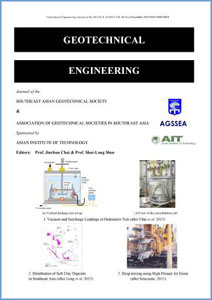Electrical Vertical Drains in Geotechnical Engineering Applications
Main Article Content
Abstract
Electrical vertical drains (EVDs) have been applied for improvement of soft clays. In this state of the art review, an overview of the theory of electrokinetics is presented, followed by discussions of the characteristics and limitations of some EVDs via laboratory and field experimental studies on electrokinetic stabilization of geo-materials. The predominant mechanism of electrokinetic stabilization includes electroosmosis, the movement of pore water in soil driven by a direct current (DC), and electro cementation induced by electrochemical reactions at electrodes. The overall effect of electrokinetic treatment is the increase in the soil shear strength and decrease in the soil compressibility. The technique has been applied successfully in geotechnical engineering, while one of the challenges is corrosion of anodes that are typically made of steel or copper. More recently, conductive polymer products have been developed, such as electrokinetic geosynthetics (EKGs) and electrical vertical drains (EVDs). This paper presents case histories on using EVDs in soil improvement. The authors hope that this review serves as a guidance for future research and development of electrokinetic treatment of geo-materials using EVDs.
Article Details

This work is licensed under a Creative Commons Attribution-NonCommercial-NoDerivatives 4.0 International License.
Copyright © 2019 Association of Geotechnical Societies in Southeast Asia (AGSSEA) - Southeast Asian Geotechnical Society (SEAGS).


